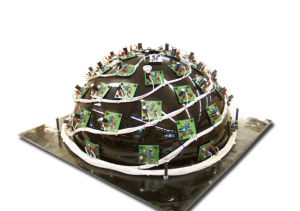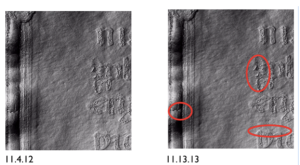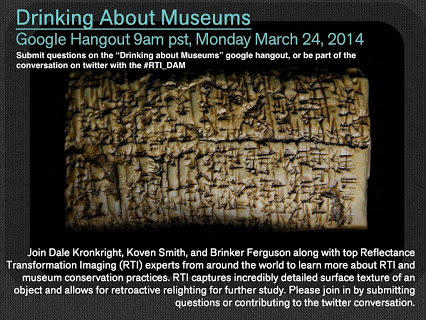Project 1 – Reflectance Transformation Imaging Dome: UCSC
Currently, in the Jack Baskin School of Engineering at the University of California, Santa Cruz, James Davis, a professor of computer science, Jing Liu, a computer science PhD student, and I, a visual studies PhD student, are working to expand and improve reflectance transformation imaging (RTI) technology to enable its greater integration into museum practice. RTI is created from information aggregated from multiple digital photographs of the object that are taken with different raking light angles and a stationary camera. Through dedicated software the researcher can then manipulate light data afterwards in such a way as to strategically reveal important surface texture information of the object.
PhD student, are working to expand and improve reflectance transformation imaging (RTI) technology to enable its greater integration into museum practice. RTI is created from information aggregated from multiple digital photographs of the object that are taken with different raking light angles and a stationary camera. Through dedicated software the researcher can then manipulate light data afterwards in such a way as to strategically reveal important surface texture information of the object.
Museum Applications
Museum photography departments are already applying RTI to many objects to reveal fine surface details that are often not visible to the naked eye. However, as useful as this tool is to a variety of fields and disciplines, it also has its limitations. What follows are several suggestions that are being investigated by our team, for pushing RTI software in new ways that could have a more lasting impact on cultural heritage institutions.
Software: Supplementing Conservation Condition Reports
 Regarding the potential software applications of RTI information, it could be useful to supplement condition reports for the museum’s conservation departments. Creating a seamless means of integration of this information into different content management systems (CMS) within the museum could also be very helpful for archival purposes. Another possible application would be to allow the Another useful application would be to compare RTI information for an object that was photographed both before and after it went out on loan, so as to determine, in a very precise and detailed method, whether there had been any damage during the trip. This difference information would provide the conservator with preventative conservation information in terms of, for example, eroding paint.
Regarding the potential software applications of RTI information, it could be useful to supplement condition reports for the museum’s conservation departments. Creating a seamless means of integration of this information into different content management systems (CMS) within the museum could also be very helpful for archival purposes. Another possible application would be to allow the Another useful application would be to compare RTI information for an object that was photographed both before and after it went out on loan, so as to determine, in a very precise and detailed method, whether there had been any damage during the trip. This difference information would provide the conservator with preventative conservation information in terms of, for example, eroding paint.
Hardware: Combining Two-Dimensional RTI Information with Photogammetry (for 3D objects)
Adding three-dimensional scanning hardware within the dome might be an interesting way to combine 3D object models with RTI surface photography. This would allow for museums to include three-dimensional sculptures in their databases, rather then just multiple images of sculptures’ different two-dimensional surfaces
Software: Making the Technology More Accessible in the Museum Gallery
Lastly, we are building more user friendly interface and developing this as an IOS app for the iPad.
Youtube Video Drinking about Museums meetup!



Leave a comment